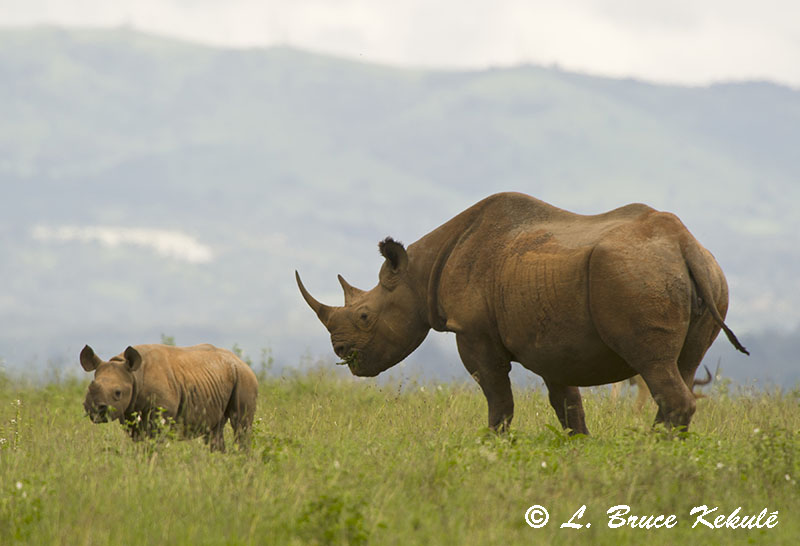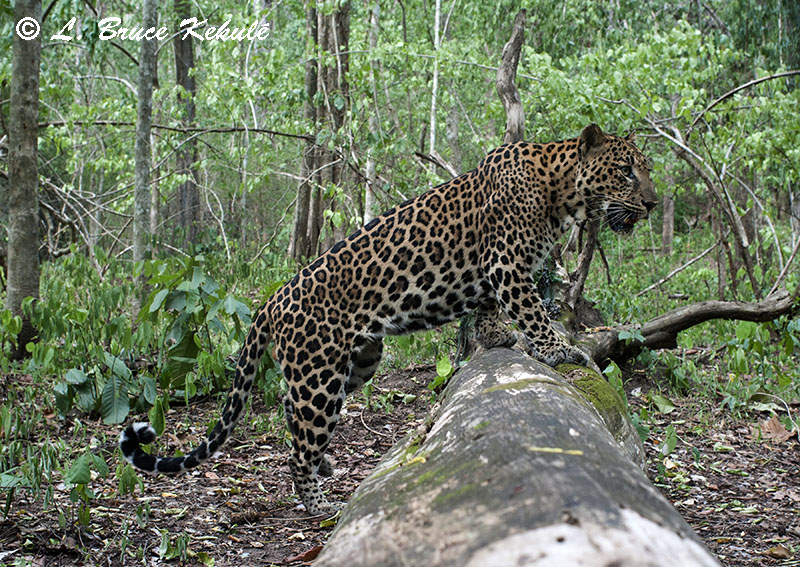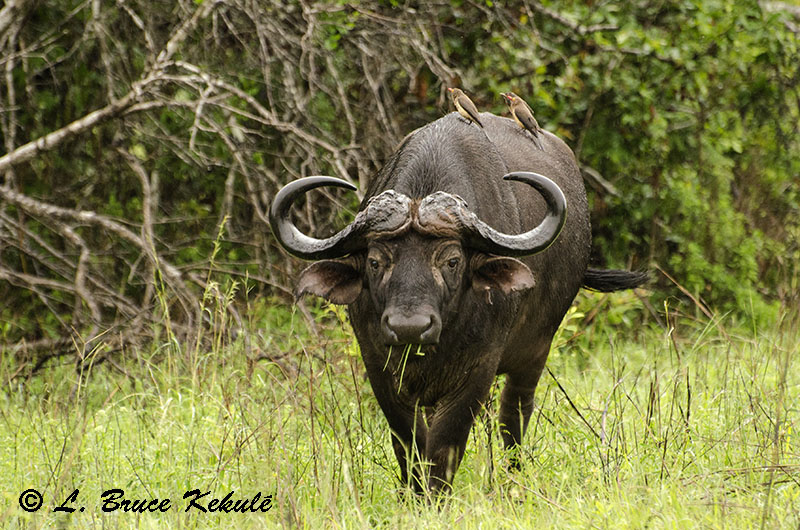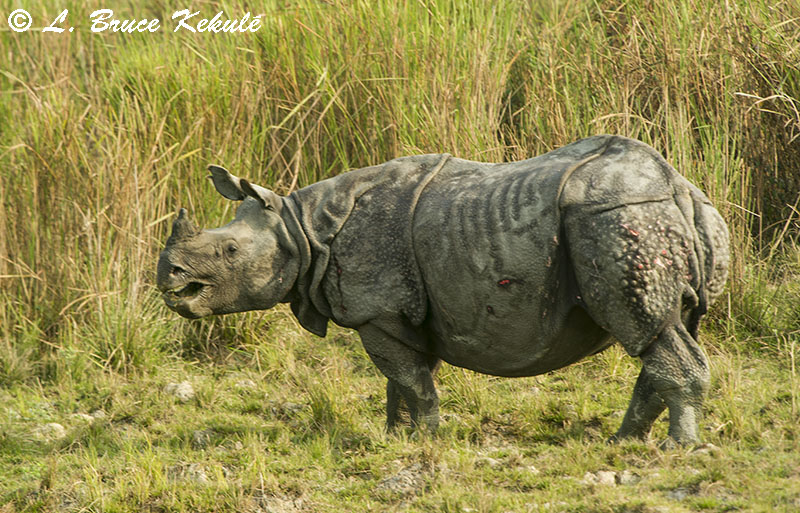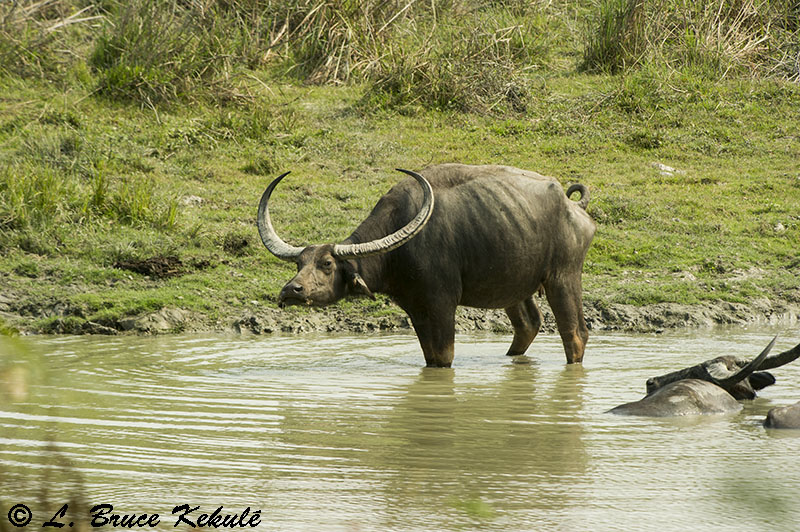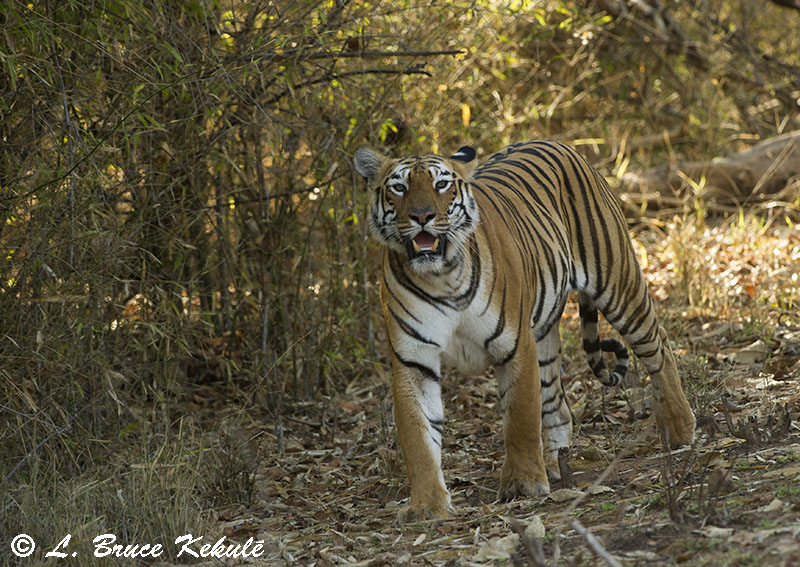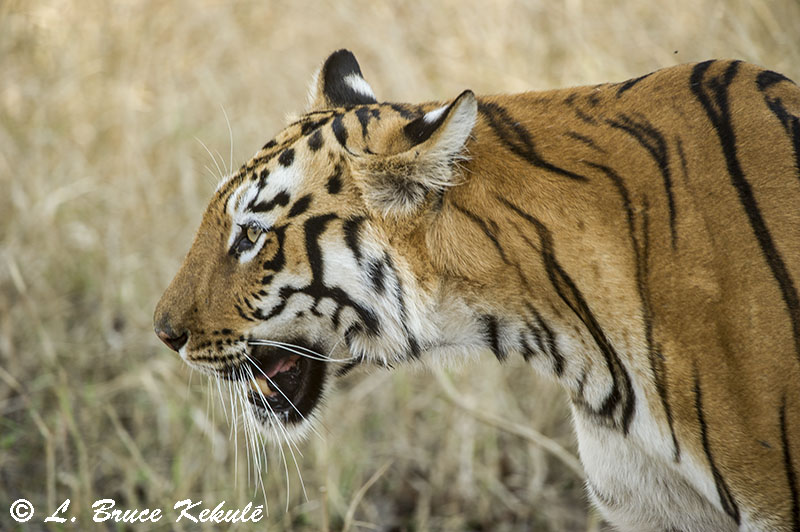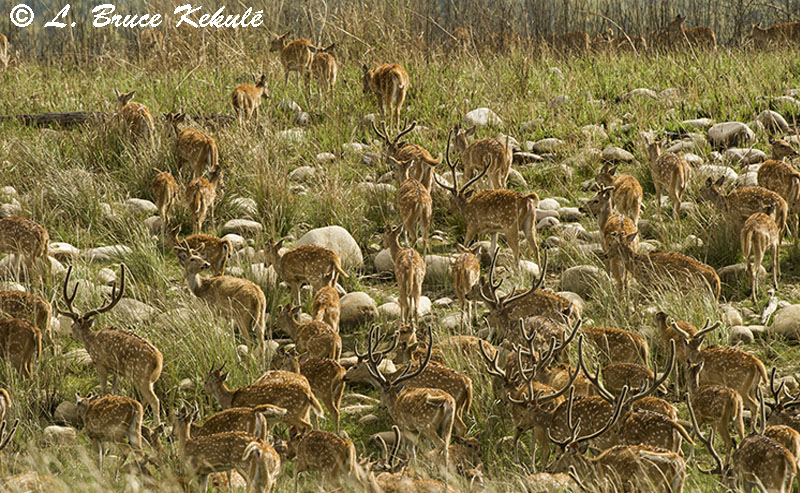Posts Tagged ‘India’s ‘Big Six’’
The Big Six: Large Dangerous Mammals of Africa and Asia
Africa’s Big Five…!
The ‘Big Five’ was coined by colonialists in East Africa by the big-game hunters sometime in the 1850s, and was trophies collected from large dangerous mammals taken with a gun. Photography was in its infant stage and very few photographs of wild animals in their natural habitat were around other than pictures of downed animals on the ground with the trophy hunter and gun bearers standing by its side.
Bull elephant in Tsavo West National Park, Kenya, during the late afternoon. This huge bull came real close to the car but passed by without incident. This was the largest tusker I had ever seen on my four safaries through 11 protected areas. Truly, a ‘wildlife icon’ of Kenya’s natural heritage. Taken with a Nikon D7000 and a 70-300 VRII lens @ 116mm. Offhand through the window.
Many rich and famous people went on safari to the ‘Dark Continent’ as it was called back then including Theodore Roosevelt, President of America and Queen Elizabeth II of Britain, plus many Hollywood movies stars like Clark Gable, Ava Gardner, Grace Kelly and Stewart Granger. Going on safari was big business just after the turn of the 20th century, and usually only the ‘well-to-do’ could afford such a journey. They came from all around the world to hunt the large animals that were thriving in great numbers on the savannas and in the bush.
The ‘Big Five’ list consisted of the elephant, rhino (black and white), Cape buffalo, lion and leopard. Most hunters used large caliber rifles to bring down these mighty beasts as trophies to be hung on a wall, or a rug on the floor in the office or home. Other parts of some creatures ended up as trash cans, ashtrays, lampshades and jewelry to name just a few. This was way before cameras came into vogue to capture these animals on film and eventually digital.
White rhino mother and calves in Lake Nakuru National Park not far from Mount Kenya in the central region. This species is identified by their wide mouth and were reintroduced from South Africa as Kenya had lost most of its rhinos to legal hunting and illegal poaching for the horn. Taken with a Nikon D3s and a Nikon 400mm ƒ2.8 on a beanbag.
Black rhino mother and calf in Nairobi National Park, Kenya. Part of the city of Nairobi is in the background and there are about 60 black rhinos trans-located from South Africa to this park. Taken with a Nikon D3s and a Nikon 200-400mm @ 650mm on a monopod…!
Cape buffalo in Tsavo East National Park, Southern Kenya. Note reddish color of this very mature bull due to red clay found in the area. Buffalo found in other areas of Kenya are mostly black. Taken with a Nikon D7000 and a Nikon 70-300mm VR II lens @ 220mm on a beanbag.
A black-maned lion in Taita Wildlife Sanctuary near Tsavo West National Park. This big cat was caught in the grassland just before the park closed for the day around 5:50pm. It was a lucky encounter. Taken with a Nikon D3s and a Nikon 200-400 VR II lens and a 2X teleconverter for 800mm on a bean-bag.
Leopard in the Masai Mara National Reserve in western Kenya. This big cat was seen and photographed on my very first day while on safari in this protected area. This was a real good start to capture the ‘Big Five’ of Africa as the leopard is the hardest to photograph in the group. Taken with a Nikon D3s and a Nikon 400mm ƒ2.8 lens on a beanbag.
Thailand’s Big Six…!
For the last twenty years, I have photographed all of Thailand’s large mammals including elephant, gaur, banteng, wild water buffalo plus tiger and leopard. It has been an excellent journey and experience for me, and I feel fortunate to have been at the right time and right place to capture these wild animals with my camera.
A tusker by the river in Sai Yok National Park in the Western Forest Complex. This shot was taken while he was fanning himself more than a decade ago and it is doubtful this big elephant is still surviving. Poachers chase after these elephants for their ivory just like everywhere else jumbos live. Taken with a Nikon F5 and a Nikon 500 P manual lens using Fuji Provia 100 slide film.
A small herd of gaur in Khlong Saeng Wildlife Sanctuary in Surat Thani province down in Southern Thailand. These herbivores thrive quite well here in this protected area along the shoreline of Khlong Saeng reservoir. This was taken with Nikon D3 and a Nikon 400 ƒ2.8 lens on a tripod setup in a boat.
Very mature banteng bull and cow at a mineral deposit in Huai Kha Khaeng Wildlife Sanctuary in the Western Forest Complex. These herbivores thrive very well in this protected area and there are estimated that more than 350 are found here. Taken with a Konica Minolta Dynax 7D and a Minolta 600mm lens from a photo blind across the river.
A wild water buffalo cow charging me by the river in Huai Kha Khaeng in the Western Forest Complex of Western Thailand. This female was part of a small herd wallowing in the waterway. Taken with a Nikon D2x and Nikon 400mm ƒ2.8 lens on a tripod mount from a boat-blind.
An Indochinese tiger at a waterhole in Huai Kha Khaeng Wildlife Sanctuary in the Western Forest Complex of Thailand. There are about 200-250 tigers left in the forests in the East and West and some in the South. They are highly sought after by poachers for tiger body parts, bones and pelt. This male tiger was caught by Nikon D700 and Nikon 400mm ƒ2.8 lens from an elevated blind.
An Asian leopard crossing a fallen log in Huai Kha Khaeng Wildlife Sanctuary in the Western Forest Complex of Thailand. This male cat was captured using a Nikon D700 trail camera with a Nikon 35mm lens and two Nikon flashes. These big cats are fairly common in this protected area and both color phases (black and yellow) can be found here.
A black leopard walking in the afternoon sun catching its spots at a hot spring in Huai Kha Khaeng Wildlife Sanctuary in the Western Forest Complex. This mature cat stayed for more than an hour waiting on prey. This was taken with a Nikon N90s with a 500mm ƒ4 lens using Fuji Provia 100 slide film.
Africa’s Big Six…!
Then in 2010, 2011 and 2012, I made four trips to Kenya in Africa and collected images from ten protected areas including the Masai Mara National Reserve that was first on the list, followed by Lake Nakuru, Samburu, Amboseli, Tsavo East and Tsavo West national parks, Taita and Shimba Hills wildlife sanctuaries, Sweetwaters private reserve and finally, Nairobi National Park capturing the ‘The Big Six’ which includes the elephant, rhino, buffalo, lion, leopard and hippo while on safari. The hippo is included in this list because they take a serious toll on humans that get in their way and are one of the most dangerous animals in Africa. Kenya has done a great job in preserving its wildlife heritage and hopefully one day I will return.
Elephant in Taita Wildlife Sanctuary in Southern Kenya between Tasvo East and West national parks. The large mammals in this area are mainly red colored due to the red clay found here. Taken with a Nikon D3s and a Nikon 600mm ƒ4 lens on a bean-bag.
Black rhino male in Nairobi National Park just outside Nairobi city in Kenya. These odd-toed ungulates were introduced from South Africa and now there are about 60 of them found here. Taken with a Nikon D700 and Nikon 200-400mm lens on a bean-bag.
White rhino in Nairobi National Park close to the Nairobi city in the background. These herbivores are now found in good numbers and were also introduced from South Africa. Taken with a Nikon D3s and Nikon 400mm ƒ2.8 lens on a bean-bag.
A Cape buffalo down in Shimba Hills Wildlife Sanctuary near Mombassa, Kenya. Due to the moist evergreen forest with loads of rain found here, the large mammals like buffalo and elephants are dark in color compared to their cousin further north that take on a red hue. Taken with a Nikon D7000 and a Nikon 70-300mm lens on a bean-bag.
A lion cub close to the road at dusk in Tsavo West National Park. These carnivores are found in good numbers here as the prey base is also good. Taken with a Nikon D3s and Nikon 600mm ƒ4 lens on a bean-bag.
A mother leopard in the Masai Mara National Reserve in Western Kenya. These carnivores thrive as prey species is very good in this protected area. Taken with a Nikon D3s and a Nikon 400mm ƒ2.8 lens on a bean-bag.
A male hippo in Tsavo West National Park in Southern Kenya. These huge herbivores live around large waterholes found in the park. They are dangerous mammals and more people die from hippo attacks then all the other big animals put together. Taken with Nikon D3s and a Nikon 600mm ƒ4 lens on a bean-bag.
India’s Big Six…!
India was next on my radar and my first trip happened in April 2013, then again in November 2014 and two trips last year (Feb-Mar & November, 2015). So far, I have visited the most famous protected areas in India consisting of Kaziranga, Ranthambore, Bandhavgarh, Corbett, Tadoba, Kanha, Pench and Satpura national parks and tiger reserves. The ‘Big Six’ list includes elephant, Indian rhino, wild water buffalo, gaur, tiger and the leopard were photographed.
Hunting back in the old days was carried out primarily by the British and India’s Royal Maharajahs, which almost wiped out many species especially the tiger. However, the country has done an amazing job of saving this species from the brink of extinction for people from around the world to see and enjoy. The balance of nature is still fairly intact and these creatures still thrive on the sub-continent in good numbers.
Bull elephant at a waterhole in Kaziranga National Park and Tiger Reserve in Assam State, Northeastern India. There are some 1,000 of these herbivores found in the park. Taken with a Nikon D3s and a Nikon 200-400mm lens on a mono-pod.
A male Indian one-horned rhino in Kaziranga National Park and Tiger Reserve. There are roughly 2,400 rhinos now and is one of the greatest conservation success stories in the world. Some 80 years ago, there were a mere 12 remaining and the Assamese government established a ‘shoot-to-kill’ policy for any poachers found in the park. Taken with a Nikon D3s and Nikon 200-400mm lens on a mono-pod.
A wild water buffalo in a waterhole in the park with huge horns. These herbivores have the largest horns in the world. There are some 1,300 buffalo found here and is one of the largest herds in the world. Taken with Nikon D3s and a Nikon 200-400mm lens on a mono-pod.
A bull gaur in Kanha National Park and Tiger Reserve, Central India. These even-toed ungulates are the largest bovine in the world standing 1.7 meters at the shoulder. Taken with a Nikon D3s and a Nikon 200-400mm lens on a mono-pod.
A male tiger named ‘Wagdoh’ (one-eye) in Tadoba Anhari Wildlife Sanctuary in Central India. There are about 2,400 tigers in India’s protected areas and is the largest population in the world. Taken with a Nikon D3s and a Nikon 200-400mm lens on a mono-pod.
A female leopard in late morning in Tadoba Anhari National Park, Central India. For the most part, leopards are tough to spot in the forests of India. However, luck does come and this beautiful girl posed for my camera on my first morning safari in March 2015. Taken with a Nikon D3s and a Nikon 200-400mm lens on a mono-pod.
In 1995, I began what will be my last profession in life when I picked up a camera some two decades ago. Photographing wildlife is the greatest thing I have ever accomplished in my 70-odd years on the planet. It has been a journey of discovery and rediscovery, and sometimes I wish I could have started wildlife photography when I first came to Thailand in 1964. The jungles and teak forests were absolutely teaming with wild creatures from Asian elephants down to tree shrews. Birds, reptiles, amphibians plus insects and spiders were also found in great numbers.
Conclusion: It is my opinion and utmost worry that some of these ecosystems and large mammals found in Thailand, Kenya and India are in jeopardy from human influences. Certain species have gone into serious decline or have even become locally extinct due to the human population explosion, and expansion into these wild places. Therefore, more is needed to protect and save the natural wonders of ‘Planet Earth’ from annihilation by the human element before it is too late. A thousand percent increase in preservation, forest management, more personnel and rangers on the ground plus more funds is the only answer. But with so many obstacles in the mix, I remain optimistic about wildlife in many forests of the future. As the natural biospheres undergo serious threats and changes to their integrity by humans, the road to extinction is at hand for many.
However, saving wildlife and the protected areas where they live with good security and enforcement must be implemented and is the key to the animal’s future survival in places like Kaziranga National Park in Assam, northeast India. Here, most guards are armed with a .303 service rifle and extreme measures are upheld to the letter; poachers are dealt with swiftly and in a deadly manner in some cases. Because of the stringent rules and protection, there are 2,400 Great Indian rhino, 1,300 wild water buffalo, 1,000 elephant and one of the highest tiger densities in the world with over 100 big cats living in a smallish (840 sq. kilometers) park. Kaziranga is the true role-model for real wildlife conservation around the world in desperate times. As more and more creatures disappear from the wild, tougher rules and regulations is the only way to guarantee their future survival…!
India’s ‘Big Six’: Majestic creatures thriving on the sub-continent…!
A photographic tour in three national parks with some pretty amazing animals
A tigress on the run in the grassland at Dhikala, Corbett National Park in the northern State of Uttarakhand.
In 2014, I made a decision to visit India once again in search of the most iconic species still thriving in three protected areas in the northeast, central and northern parts of the country. Kaziranga, Tadoba and Corbett national parks and tiger reserves respectively, were chosen for their wildlife biodiversity with the tiger at the top of the list. I visited the three from February 22 through March 16, 2015.
A mature bull elephant with some impressive ivory in Kaziranga National Park.
I wanted to photograph the big six: elephant, rhino, gaur, wild water buffalo, leopard and the tiger. I was extremely lucky encountering all of these amazing animals during this trip. This has definitely left a huge impression on me and is etched in memory. India’s wildlife and protected areas are some of the best places in the world to see Mother Nature’s wonderful creatures.
Male One Horned Indian rhino 10 minutes from the front gate on my first day in Kaziranga National Park.
A century ago, India was teeming with wildlife. There were some 40,000 tigers found here but that number quickly dropped primarily due to habitat loss after World War II when the population really began to surge and forest areas were overcome, and turned into agriculture fields and estates. Hunting on a grand scale was also responsible for the disappearance of the tiger.
Wild water buffalo cow in Kaziranga National Park.
In 2011, there were only about 1,706 tigers left but in 2014 after better methodology and camera trapping, that number increased to 2,226 individuals found throughout the continent. As a result of mass awareness and conservation measures, the tiger population has rebounded showing a remarkable growth of 30% in the past three years. But some scientists believe this number to be inflated and put the amount of tigers around the 2,000 mark.
A bull gaur with an extremely long tongue in Tadoba National Park.
On 22nd of February 2015, I boarded Air India for the 4-hour flight from Bangkok to New Delhi arriving at noon. After a quick hair-raising taxi ride through the city, I got to the hotel spending one night to rest-up in order to catch the next morning’s flight to Gauhati, the largest city in the State of Assam in northeast India. The hustle and bustle through the domestic airport in Delhi is very tight on security as it should be. But once through the x-ray machines, a bit of a breather and a coffee is welcome. You must get there at least three hours early because of the amount of flights leaving, and the thousands of people trying to catch their respective connections.
A female leopard during late morning in Tadoba National Park.
Kaziranga National Park: State of Assam
A young bull elephant in Kaziranga National Park.
I wanted to visit Kaziranga National Park with the objective of finding out why this place is the number one protected area in the world, and my top priority was the Great Indian one-horned rhino, and then on my list was the wild water buffalo, elephant and tiger in that order. I got the big three but the tiger remained elusive.
A water buffalo photographed by my friend Polash Borah.
My newly acquired friends, Polash Borah and Mohammed Nekib Ali, my naturalist and driver respectively were a big help in locating these large mammals. I let Polash use my Nikon D7000 with a brand new Nikon 70-200mm VRII lens, and he got a really nice buffalo shot posted here. I also managed to get some good photographs myself. It was a great trip and I met some very nice people.
A young one-horned rhino up-close. He was a curious fellow wanting to know who we were.
I will be going back to Kaziranga maybe in November of this year when the skies are clear blue and the air is crisp wanting to get some nice scenic shots especially of the wide Brahmaputra River that runs through the park from the Himalayas in the background, and the lush swamps and grasslands after the monsoon rains.
A mature wild water buffalo bull near a waterway in Kaziranga National Park.
Probably the most important fact concerning Kaziranga is that some 80 years ago, there were about 12 rhinos left here. The Government of Assam decided to do something and implemented some serious laws with a ‘shoot-to-kill’ policy on all poachers and illegal squatters, plus an increase of several hundred personnel. At last count, there are 700 rangers and 161 ranger stations to look after a small 430 square kilometer core area, and a 400 square kilometer buffer zone. After a census last year, there are over 2,400 rhino, 1,500 wild water buffalo and 1,200 elephant. Over 120 tiger have been recorded here and prey species also number in the thousands. In my opinion, it is probably the best-protected area in the world…!
Tadoba National Park: State of Maharashtra
A tiger named ‘Maya’ in Tadoba National Park; she is the most famous tigress seen almost everyday.
After four days in Assam, I flew back to New Delhi for a two-day rest and then boarded a flight on March 3 in the morning down to Nagpur further south. Then a two-hour taxi ride was needed to Tadoba National Park and tiger reserve in the State of Maharashtra. Arriving at the lodge in mid-afternoon, a needed rest and some lunch was in order. I did not go out on safari that afternoon because the park is closed on this day.
‘Maya’ up-close as she walked the road marking her territory.
The next morning’s safari netted a beautiful female leopard highlighted by some wonderful back-light. My spirits were up a hundred percent after photographing the spotted cat.
Female leopard jumping in front of our jeep.
Female leopard up-close as she checks her surroundings.
The next morning as we were rolling around the dusty roads, we bumped into a big crowd of jeeps but they were at the far-end of a one-way road. We waited and saw a tiger walk out of the forest near the jeeps but melted back in. The group then moved close to us but the tiger stayed in the forest. My driver Lahu from the Tiger Trails Lodge has been driving for the owner of the lodge for some 35 years, and knew exactly where the big cat would come out. And as sure as the sun comes up everyday, she popped out and walked right in front of us.
‘Maya’, the female tiger queen in Tadoba National Park: This was my last sighting of this beautiful cat.
I did not stop shooting as Maya, (probably the most popular tigress in Tadoba at the moment) walked along the road spraying and marking her territory. My new friend Dr Sundran Rajendra was with me, and the both of us were so elated that we just kept on shooting our cameras. Then time was up and we had to leave the beautiful cat to herself. It was Sundran’s first tiger and he managed to get some very nice shots of the big cat. She came so close I could almost touch her.
Another tigress, named ‘Choti Tara’ fitted with a radio collar snarls at my friend Dharmendra Sharma.
My other friend and naturalist with the lodge Dharmendra Sharma, was in another jeep so I let him use my Nikon D7000 and the new Nikon 70-200mm VR II, and he got some very nice photos of another female named ‘Choti Tara’ fitted with a radio collar. He also got a few nice shots of Maya.
Male tiger named ‘Gabbar’ fitted with a ‘radio collar’ in pretty bad shape.
On my last afternoon safari in Tadoba, I bumped into ‘Gabbar’, a male tiger also fitted with a collar. He got swatted by another male and was in pretty bad shape. But the wheels are in motion to fix him up. I just hope that the squeaky Indian bureaucracy does not wait too long to help this tiger, as he could turn into a cattle killer or even worse, a man-eater. Needless to say, news on Facebook is that he did kill a village buffalo but is OK for the moment, and is being monitored. After four days, I was back on the plane to New Delhi for a two-day rest before heading north to India’s first national park.
Corbett National Park: State of Uttarakhand
A young tigress stalking a herd of spotted deer in the grassland of Corbett National Park.
It takes about four to five hours north of Delhi by taxi through some very congested and dangerous traffic in the State of Uttar Pradesh to get to Ramnagar, a city in the State of Uttarakhand where Corbett National Park, India’s first national Park. It is situated in the foothills of the great Himalayas. I spent the first night at the Forest Department’s lodge at Bijrani, and went on safari that afternoon and then again the next morning.
A golden jackal on the run near the Forest Department’s lodge at Bijrani.
I did not see a tiger but the big cats were around as other jeeps that I bumped into got some nice close-up photos taken with an iPhone. An occupant in one of the vehicles gave me a telephone slide show. I did see a pair of golden jackals early in the morning and then later a small family unit of elephants. One old cow did a mock charge and came within 15 meters but stopped short and turned around going back to her calf. The elephants then faded off into the forest.
Elephants near the Forest Department lodge at Bijrani.
Around 12-noon, we left this section and went over to the Forest Lodge at Dhikala that is the best site in Corbett to see tigers. Near the lodge, there is a grassland savannah that attracts herbivores like spotted deer in great numbers, and of course many tigers come looking for prey. It is said the park has some 200 tigers, one of the highest densities in India.
A herd of more than 100 spotted deer; the prime food source for tigers in Corbett National Park.
On the second morning, we bumped into a young hunting tigress stalking a herd of over a hundred deer. Me, my naturalist Devendra Singh Neui and my driver Rasheed Ali, were the only ones at this location as all the other jeeps from the lodge (about 10 of them) were waiting for tigers by the forest road. She tried several times unsuccessfully to chase down a deer but the herbivores were on to her. I managed to get some really great images in the process.
The tigress on the run after spotted deer not far from the Forest Department’s lodge at Dhikala.
Later in the afternoon, the camp was abuzz with the news that a tiger was in the lower grassland, and after lunch, they all headed that way and waited nearby. When she appeared, the group went wild chasing after her but they all came up short. We hung back and this very smart tiger circled around to avoid them. I saw her one more time slinking in the grass as the light was fading but time was up as I snapped a few last frames. I had a great time here and have vowed to return to this remarkable place…!
The unlucky tiger chasers in the grassland of Dhikala, Corbett National Park.
The trip to Corbett was scheduled on very short notice by my agents Anu Marwah in New Delhi, and Jason Fernandes in Mumbai both wildlife photographers of great standing in India. They are joint owners of Wilderness Uncut (wildernessuncut.com), a company set-up to cater to wildlife photographers, naturalists and bird watchers. Their superb management and arrangements are first class with absolutely no hiccups and they are reasonable priced. It was a great, enjoyable and memorable trip for me. I can honestly say that I need look no further for anyone to help me with any of my up-coming trips to India.
The female tiger in the grassland of Corbett: this was my last sighting of this beautiful tigress.
One point that I must make here! You never get tired of seeing the world’s biggest cat and is one of the greatest predators that ever walked the face of the Earth. My thoughts are always with these felines and their future survival. Unfortunately, the future for the tiger looks dim, as the situation concerning the Asian medicine trade using their bones seems to be getting worse with more and more stories on the net and in the papers about this draconian belief. The biggest culprits are China, Vietnam, Laos and Thailand (Chinese in Thailand) that perpetuate this market. The tiger needs the whole world to stand up to these people and this illicit trade must be stamped out soon but it carries on with impunity. Until action is taken with economic sanctions and other means against the countries involved, this illegal black-market will continue to take the wild tiger into the dark depths of extinction.




